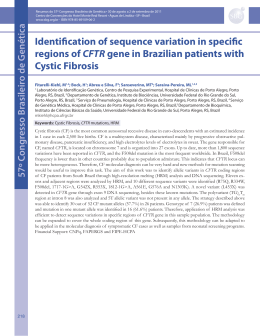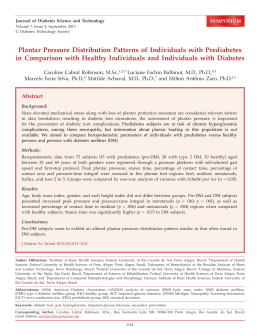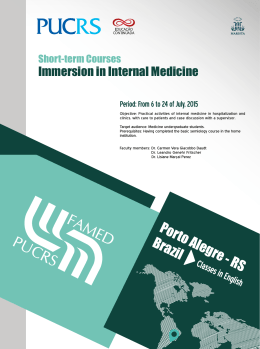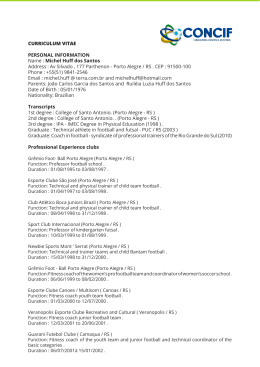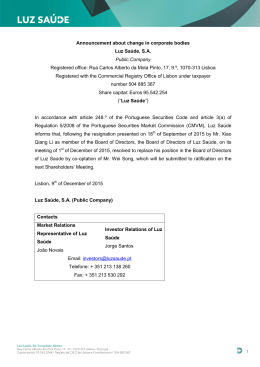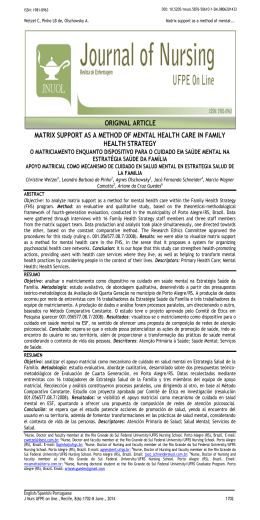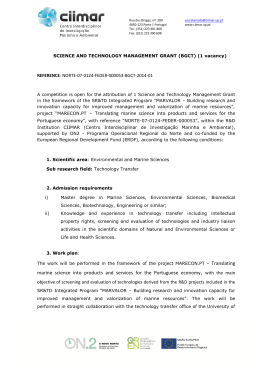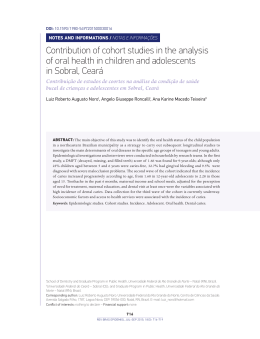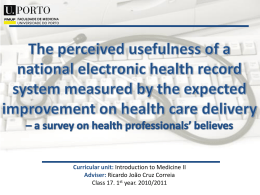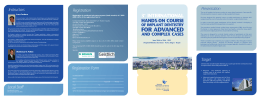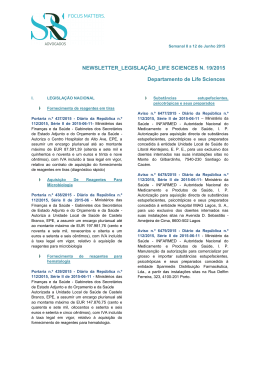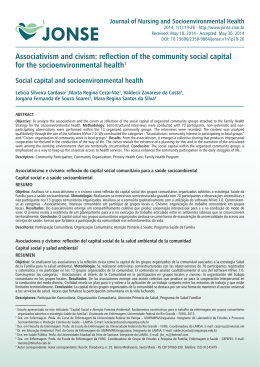DOI: 10.1590/1809-4503201400040018 NOTAS E INFORMAÇÕES / NOTES AND INFORMATIONS The Porto Alegre Early Life Nutrition and Health Study A Pesquisa de Nutrição e Saúde na Infância de Porto Alegre Benjamin Wilk ChaffeeI, Márcia Regina VítoloII, Carlos Alberto FeldensIII ABSTRACT: Early childhood caries is a persistent worldwide problem. The etiologic contribution of feeding practices has been less frequently investigated in prospective studies of young children. The Porto Alegre Early Life Nutrition and Health Study has followed a birth cohort of 715 mother-child pairs, recruited from municipal health centers, originally involved in a cluster-randomized controlled trial of healthcare worker training. The birth cohort links prospectively collected socio-demographic, infant feeding, and general and oral health information. To date, oral health data, including caries status and oral health-related quality of life, have been collected for 458 children at the age of 2-3 years. Studies are underway to investigate possible determinants and consequences of oral health among these children. Keywords: Child, preschool. Feeding behavior. Dental caries. Cohort studies. Child. Intervention. RESUMO: Cárie dentária na infância continua apresentando alta prevalência em todo o mundo. Poucos estudos prospectivos investigaram a participação de práticas alimentares na etiologia deste agravo. A Pesquisa de Nutrição e Saúde na Infância de Porto Alegre está acompanhando uma coorte de 715 pares mãe-filho, recrutados de unidades básicas de saúde e que participam de um ensaio clínico de cluster em que a intervenção foi realizada com profissionais da saúde. A coorte ao nascimento está investigando a associação entre dados sociodemográficos e alimentação infantil, com informações de saúde geral e saúde bucal, prospectivamente coletados. Até o momento, dados de saúde bucal, incluindo cárie dentária e qualidade de vida relacionada à saúde bucal, foram coletados de 458 crianças com 2 a 3 anos de idade. Pretende-se investigar possíveis determinantes e consequências das condições de saúde bucal nestas crianças. Palavras-chave: Pré-escolar. Comportamento alimentar. Cárie dentária. Estudos de coortes. Criança. Intervenção. University of California – Berkeley (CA), United States of America. Universidade Federal de Ciências da Saúde de Porto Alegre – Porto Alegre (RS), Brazil. III Universidade Luterana do Brasil – Canoas (RS), Brazil. Corresponding author: Márcia Regina Vítolo. Universidade Federal de Ciências da Saúde de Porto Alegre. Rua Sarmento Leite, 245, CEP: 90050-170, Porto Alegre, RS, Brasil. E-mail: [email protected] Financial support: The Brazilian Ministry of Health. Fundação de Amparo à Pesquisa do Estado do Rio Grande do Sul (FAPERGS). National Institutes of Health (NIH-NIDCR) F30DE022208. I II 1015 REV BRAS EPIDEMIOL OUT-DEZ 2014; 17(4): 1015-1018 CHAFFEE, B.W., VÍTOLO, M.R., FELDENS, C.A. CONTEXT Caries is among the most common childhood afflictions worldwide1,2, and Brazil is no exception1. Its high prevalence, despite advances in preventive practice, suggests a need for additional early-life interventions. Diet-based programs offer promise, as feeding practices contribute to caries development.3 Additional longitudinal studies would provide further evidence for future interventions. STUDY OVERVIEW The Porto Alegre Early Life Nutrition and Health Study follows a birth cohort of 715 mother-child pairs initially recruited for the evaluation of a cluster-randomized trial4,5. The trial evaluated the effectiveness of healthcare worker training in a set of infant feeding guidelines to improve both general and oral health in early childhood. With prospectively gathered data on feeding habits, demographics, and general health, this nested cohort can be used to relate observed behaviors and conditions to oral health. Porto Alegre is a city of 1.4 million residents with a fluoridated public water supply. Thirty-one of the city’s 52 municipal health centers met trial eligibility criteria, of which 20 were randomly selected. Municipal health centers are accessible to all residents of the city, but the patient population tends to pertain to low socio-economic position. In early 2008, enrolled health centers (n = 20) were randomized either to an intervention consisting of training in infant feeding guidelines: the “Ten Steps of a Healthy Diet for Brazilian Children under Two Years of Age,” plus material for patient distribution4,5. The guidelines contain no specific oral health messages. Control clinics continued usual practices. All pregnant women at participating health centers were invited to enroll for a follow-up of health outcomes in their children; 97% (715/736) consented. Assessments took place at approximately 6 (n = 633), 12 (n = 545), and 38 (n = 475) months, and the final included an oral health evaluation. The average duration of exclusive breastfeeding was increased4, but caries incidence was not significantly reduced5. DATA COLLECTION Data were collected via questionnaires and physical assessments. Fieldworkers underwent extensive training and calibration. Socio-demographic information was collected at baseline through interviews with pregnant mothers. Variables included household size, family structure, parental education, family income, social class, and maternal smoking. At later time points, mothers were asked about child size at birth, respiratory symptoms, use of medications, hospitalizations, diarrhea occurrence, iron supplements, television and sleeping 1016 REV BRAS EPIDEMIOL OUT-DEZ 2014; 17(4): 1015-1018 THE PORTO ALEGRE EARLY LIFE NUTRITION AND HEALTH STUDY habits, daycare/preschool attendance, family health history, and maternal attitudes regarding feeding and the adequacy of the child’s diet. Feeding practices: mothers were asked about breastfeeding practices, including the durations of breastfeeding, exclusive breastfeeding, and the frequencies of day and night nursing. The timing of the introduction of beverages (water, tea, juices), solids (cereals, meat, fruits and vegetables) and low nutrient density foods (desserts, candies, sweetened beverages) was recorded. For children receiving foods other than breast milk, mothers completed two 24-hour diet recalls on non-consecutive days. Mothers were asked to list all foods and liquids consumed by their children during the prior 24 hours, including details, such as portions, preparation methods, and nursing bottle use. Data were compiled using software (NutWin version 1.5, Federal University of São Paulo, São Paulo, Brazil). Tota energy and nutrient content were estimated from USA Department of Agriculture food composition tables or from manufacturers’ labels. Physical assessments: anthropometric measurements included child height, weight, and skinfold thicknesses, and maternal height, weight, and waist circumference. Child blood hemoglobin concentration was assessed via finger puncture and direct reading using a portable photometer (HemoCue AB; Angelholm, Sweeden). Oral Health Related Quality of Life: at age 2-3 years, interviewers utilized the Brazilian Early Childhood Oral Health Impact Scale (B-ECOHIS), a 13-item questionnaire designed as a proxy measure of the oral health related quality of life of preschool-aged children and their families6. Oral Health Evaluations: from August 2011 to June 2012, a dentist collected oral health data for 458 of the 475 children followed to 2-3 years of age. Evaluations were visual, following WHO protocol7. Non-cavitated (white spot) lesions were also recorded. Assessments were under ambient light using a lighted intraoral mirror (DenLite, Miltex, Inc. York, USA) with the child seated. Two calibrated dentists performed the assessments under identical protocol. The estimation of inter-rater reliability (unweighted kappa 0.75) and intra-rater reliability (unweighted kappa 0.83 for both examiners) is detailed elsewhere5. Dental trauma was evaluated in the anterior region, including canines. This included soft tissues (fistula or edema), hard tissues (fractures of enamel, enamel and dentin, or involving the pulp), and supporting structures (subluxation, lateral dislocation, intrusive luxation, extrusive luxation, or avulsion). The examiner then brushed all teeth before drying with gauze. Each tooth surface was recorded as sound, decayed non-cavitated (white spot), cavitated (frank lesion), missing due to caries, restored, or restored with decay. Hypocalcification was defined as demarked or diffuse enamel opacity and hypoplasia as translucent or opaque localized reduction in enamel thickness appearing as pits, grooves, or loss of enamel. The prevalence of any decay was 55% (250/458); cavitated decay was found in 40% of children (181/458). The mean number of affected surfaces was 3.2 (SD 6.2); excluding whitespot lesions, this value was 2.6 (SD 5.9). 1017 REV BRAS EPIDEMIOL OUT-DEZ 2014; 17(4): 1015-1018 CHAFFEE, B.W., VÍTOLO, M.R., FELDENS, C.A. CURRENT AND FUTURE RESEARCH Investigations are underway to examine relationships between the feeding habits and oral health status observed in this cohort. Possible determinants to be evaluated include diet, including breastfeeding habits and complementary food introduction, socio-demographic characteristics, and maternal perceptions of diet quality. Also of interest are associations of nutrition status and diet quality with general health conditions such as obesity and anemia. Continued follow-up is planned. ETHICS AND FUNDING Ethical research committees at the Universidade Federal de Ciências da Saúde of Porto Alegre (UFCSPA) and the University of California Berkeley approved this study. Informed consent was reached with mothers on behalf of their children. Children with caries or suspected anemia, under- or overweight status were referred for care. The Brazilian Ministry of Health and Fundação de Amparo à Pesquisa do Estado do Rio Grande do Sul (FAPERGS) supported all phases of research. BWC was supported by NIH-NIDCR grant F30DE022208. This trial is registered at ClinicalTrials.gov (NCT00635453). The authors have no relevant financial relationships and report no conflicts of interest. SUMMARY The Porto Alegre Early Life Nutrition and Health Study is a source of detailed, prospectively collected infant feeding information from a birth cohort of low-income children in an urban Brazilian setting. This study should help characterize the role of early life feeding practices, general health, and other factors in caries development. REFERENCES 1. Ministério da Saúde. Projeto SBBrasil 2010: Pesquisa Nacional de Saúde Bucal – Resultados Principais. Brasília; 2011. 2. Kramer PF, Feldens CA, Ferreira SH, Brevian J, Rodrigues PH, Peres MA. Exploring the impact of oral diseases and disorders on quality of life of preschool children. Community Dent Oral Epidemiol 2013; 41(4): 327-335. 3. Feldens CA, Giugliani ERJ, Duncan BB, Drachler ML, Vítolo MR. Long-term effectiveness of a nutritional program in reducing early childhood caries: a randomized trial. Community Dent Oral Epidemiol. 2010; 38(4): 324-32. 4. Bernardi JR, Gama CM, Vítolo MR. Impacto de um programa de atualização em alimentação infantil em unidades de saúde na prática do aleitamento materno e na ocorrência de morbidade. Cad Saude Publica. 2011; 27(6): 1213-22. 5. Chaffee BW, Feldens CA, Vítolo MR. Clusterrandomized trial of infant nutrition training for caries prevention. J Dent Res. 2013 ;92(7 Suppl): 29S-36S. 6. Tesch FC, Oliveira BH, Leao A. Equivalência semântica da versão em português do instrumento Early Childhood Oral Health Impact Scale. Cad Saude Publica. 2008; 24(8): 1897-909. 7. World Health Organization. Oral health surveys, basic methods, 4th edition. Geneva; 1997: p. 4-51. Received on: 03/22/2013 Accepted on: 01/24/2014 1018 REV BRAS EPIDEMIOL OUT-DEZ 2014; 17(4): 1015-1018
Download



